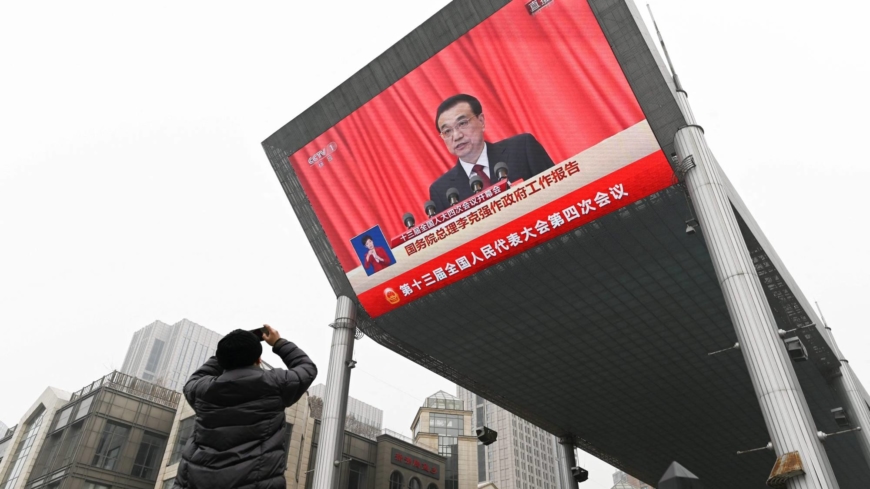[ad_1]
China’s first road map to achieving net zero emissions by 2060 may be too slow to stop the world’s biggest polluter from hastening global warming.
Thousands of Chinese delegates applauded when Premier Li Keqiang stood in the Great Hall in Beijing at the start of the National Party Congress on Friday and said the country will act strongly on climate change. The country’s 14th five-year plan, released later that morning, was awash with ways to increase the use of renewable energy by 2025.
But when it came to greenhouse-gas emissions — the key metric that will determine whether the world reins in a global temperature increase — Friday’s announcements were disappointing. Beijing didn’t set a hard target for the emissions, nor did it bring forward from 2030 the date it expects them to peak. The only carbon goal announced — reducing emissions per unit of gross domestic product by 18% over five years — was the same as in 2016.
“To tackle the climate crisis, China needs to bring its emission growth to a much slower level,†said Li Shuo, senior global policy adviser at Greenpeace in Beijing. “Peaking emissions earlier than 2025 is not only possible but necessary.â€
The new five-year plan is the latest sign that China is employing a two-speed approach to tackling climate change. In the near term, it’s offering incremental improvements, such as reducing the intensity of emissions, while spending on research into technologies such as hydrogen and battery storage that it hopes will allow the nation later on to accelerate efforts to meet its 2060 goal.
The slow start is a reflection that the government needs to restore steady growth to the world’s second-largest economy even as much of the planet remains in the grip of the pandemic, to help preserve social order and continue reducing poverty.
Uncertainty over how quickly that can happen is reflected in the plan, which, for the first time in recent history, doesn’t include a five-year numerical target for GDP growth.
Among the energy and climate goals announced are to:
Get 20% of its energy from non-fossil fuel sources by 2025, up from 15.9% in 2020 Reduce energy use and carbon emissions per unit of GDP by 13.5% and 18%, respectively Boost nuclear power capacity to 70 gigawatts, from nearly 50 gigawatts at the end of last year. More targets may be coming later this year, when the government is expected to release a separate five-year plan for the energy sector. Premier Li also promised a work plan this year to show how China aims to reach peak emissions by 2030.
The lack of a numerical GDP target in Friday’s announcement may be a signal that the government wants to turn away from relying on energy-intensive industries to meet specific goals, said Jonathan Luan, a BloombergNEF analyst. The plan offered broad-based support for wind and solar power and promised more developments for hydrogen and energy storage. But it stopped short of committing to a reduction in the use of fossil fuels.

China mines and burns half the world’s coal, the most polluting major energy source. Premier Li said China would continue to promote the clean and efficient use of the fuel through the next five years. Earlier this week, the sector’s leading industry group said consumption would likely be slightly higher in 2025 than it was in 2020.
Indeed, the latest plan highlighted the importance of continuing to increase domestic production of coal, oil and natural gas to improve energy security, a key concern for the world’s largest importer of all three fuels.
China’s economic ascent over the past four decades to become the biggest producer of greenhouse gases has been rapid, but it still hasn’t pumped as much CO2 into the atmosphere as the U.S. and Europe, which began their industrial revolutions more than a century earlier. Nor is it the worst offender on a per-capita basis.
But the reality is that the world needs to curb emissions as fast as possible and China currently accounts for 30% of global output. It was the only major economy that saw an increase last year after the pandemic hammered economic growth elsewhere, according to research firm Rhodium Group.
Climate scientists worry that China’s modest goals won’t slow the increase in emissions fast enough. For example, the goal of getting 20% of the nation’s energy from non-fossil fuel sources is only a modest acceleration to the pace of growth over the past five years, said Lauri Myllyvirta, lead analyst for the Center for Research on Energy and Clean Air. If China charted a linear path to 25% clean energy by 2030, laid out by Xi in December, it would need to hit 20.7% by 2025.
“The picture is one of very gradual progress in aligning China’s energy and emissions trends with the target of achieving carbon neutrality by 2060,†Myllyvirta said. “The overall five-year plan just left the decision about how fast to start curbing emissions growth and displacing fossil energy to the sectoral plans expected later this year.â€
To be sure, the new five-year plan does give China a realistic chance of meeting both of Xi’s goals of peak emissions by 2030 and carbon neutrality by 2060, said Alex Whitworth, head of Asia-Pacific power and renewables research at consultant Wood Mackenzie Ltd.
But the two-speed approach comes with risks. If technology doesn’t develop as expected, China will have made it even tougher for future generations.
Meanwhile China continues to pump heat-trapping gases and particles into the atmosphere, giving the world a slimmer chance of meeting the ambition in Paris to keep the global temperature rise to below 1.5C.
“China won’t be back on the decarbonization pathway until Beijing checks the coal construction boom and greens its Covid recovery,†said Greenpeace’s Li.
In a time of both misinformation and too much information, quality journalism is more crucial than ever.
By subscribing, you can help us get the story right.
[ad_2]
Source link







